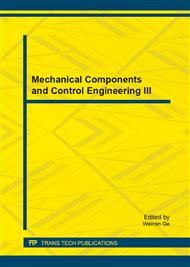p.1162
p.1166
p.1170
p.1174
p.1178
p.1182
p.1189
p.1194
p.1198
Research on a Kind of Quick Background Motion Compensation Algorithm Based on BRISK Operator
Abstract:
In order to solve the real-time problem in the background motion compensation in video sequence, a kind of quick background motion compensation algorithm based on BRISK operator has been proposed in this paper. Firstly, feature points of two adjacent frames images was extracted and matched by using BRISK operator. Secondly, the motion vector of the neighboring frames images was calculated by using the least square method (LSM). Lastly, the video sequences were compensated by using bilinear interpolation method. The simulation results show that real-time can arrive at ms grade and meet the requirement of background motion compensation.
Info:
Periodical:
Pages:
1178-1181
Citation:
Online since:
October 2014
Authors:
Price:
Сopyright:
© 2014 Trans Tech Publications Ltd. All Rights Reserved
Share:
Citation:


